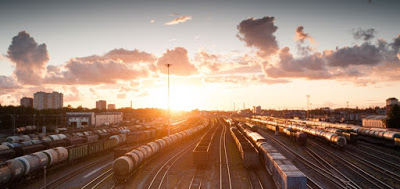Dive Brief:
- Cities like Atlanta, Chicago and Dallas
are experiencing growth in industrial real estate construction stoked by
the rising role of inland rail hubs near those cities, according to a
recent report from JLL Research. - “There is a direct linkage to rail
volume growth and warehouse inventory growth,” the report said, which
puts the growth in industrial real estate in those three markets at 3-12%
in the last five years. - Some of this growth is coming from the
railroads themselves as Class I railroads begin massive infrastructure and
technology improvements seeking greater efficiency.
Dive Insight:
Railroads have gained a fair bit of business in light of 2017 and 2018’s
trucking capacity crunch, shifting the warehouse needs of the U.S. and bringing
more industrial development to cities with hubs for intermodal rail.
trucking capacity crunch, shifting the warehouse needs of the U.S. and bringing
more industrial development to cities with hubs for intermodal rail.
Increased traffic between coastal ports and inland transit hubs have led
to non-stop or expedited service, making cities near these hubs desirable for
warehouse renters.
to non-stop or expedited service, making cities near these hubs desirable for
warehouse renters.
“These non-stop ‘hot trains’ typically have fewer delays for
the end user, as containers may only be handled or ‘touched’ two or three
times before arriving at the beneficial cargo owner’s (BCO) loading dock,”
according to the report.
the end user, as containers may only be handled or ‘touched’ two or three
times before arriving at the beneficial cargo owner’s (BCO) loading dock,”
according to the report.
JLL’s Director of Research George Cutro told Supply Chain Dive that
intermodal yards act somewhat like 3PL sort centers — serving as a bridge
between coastal ports and shipper pickups.
intermodal yards act somewhat like 3PL sort centers — serving as a bridge
between coastal ports and shipper pickups.
If you have thousands and thousands of containers coming in via ship, it
makes more sense to pick them up at an intermodal yard than to try to truck
them to your warehouse,” said Cutro, adding that large retailers heavily
reliant on imports are more likely to seize on these rail hub adjacent cities
than 3PLs, for example, which are more likely to be receiving product from
domestic manufacturers.
makes more sense to pick them up at an intermodal yard than to try to truck
them to your warehouse,” said Cutro, adding that large retailers heavily
reliant on imports are more likely to seize on these rail hub adjacent cities
than 3PLs, for example, which are more likely to be receiving product from
domestic manufacturers.
LL posits that in light of current work by railroads in the areas of
infrastructure and efficiency, the growth in rail freight is unlikely to
subside and the construction growth along with it — especially because some of
this growth is coming from the railroads themselves.
infrastructure and efficiency, the growth in rail freight is unlikely to
subside and the construction growth along with it — especially because some of
this growth is coming from the railroads themselves.
“Some of it has to do with the fact that their infrastructure is
outdated and needs to be updated. They’re adding capacity, they’re adding
sidings. They’re finding areas where they can make the tracks wider and have
some areas where they can go a little faster,” said JLL Research Manager
Chad Buch. And where the rail capacity grows, developers will follow close
behind.
outdated and needs to be updated. They’re adding capacity, they’re adding
sidings. They’re finding areas where they can make the tracks wider and have
some areas where they can go a little faster,” said JLL Research Manager
Chad Buch. And where the rail capacity grows, developers will follow close
behind.
Supply Chain Dive

